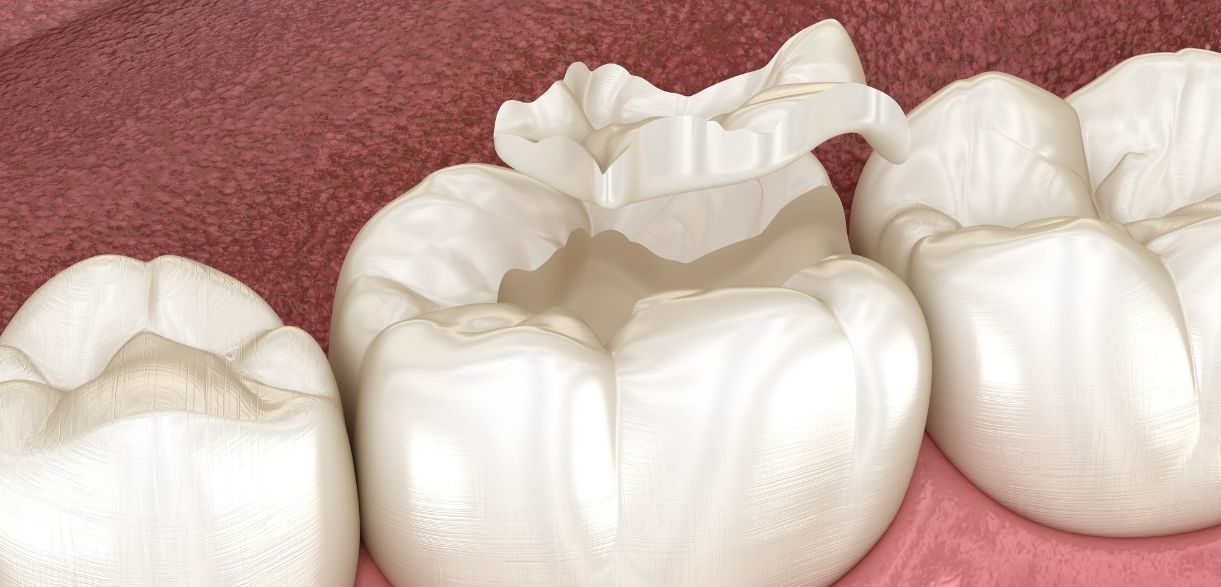Pay Online
Inlays vs. Onlays: What’s the Difference and Which Is Right for You

Has your dentist ever mentioned dental restorations, but you are confused about what an inlay or an onlay is? You are not alone. Dental terminology can become very confusing with all the options concerning anything other than simple fillings and crowns.
Enter inlays and onlays- the next best solutions after a simple filling and full crown. What actually are they, and how would you know which fits best for your smile?
Go through the blog to understand in detail what inlays and onlays are.
What Are Inlays and Onlays?
Inlays and onlays are indirect restorations custom-made in a laboratory and generally bonded to the tooth by a professional dentist. They are usually used when a tooth has too much damage for a regular filling but not enough to qualify for a full crown.
- Inlay: An inlay is applied in the grooves of a tooth between the cusps.
- Onlay: An onlay, conversely, extends beyond one or more of those cusps and, hence, covers more surface area on the tooth.
Both types involve porcelain, resin, or even gold — all durable materials that mimic the natural tooth in appearance while also restoring strength and function.
Inlays vs. Onlays: What Is The Difference?
Inlay and onlay, initially speaking, look so similar — and they are indeed in many aspects. However, the main difference is the extent of coverage of tooth structure.
- Inlays restore the interior of the affected tooth. They are the exact puzzle pieces shaped to fit perfectly within the contours of some tooth.
- Onlays take things further. Onlays fill in the inner area and cover one or more of the outer cusps, thus coping with more extensive damage.
If you need a picture, an inlay would fix the valleys of a mountain, whereas an onlay would fix the peaks.
Both procedures usually require two appointments: the first one for taking impressions and the second one for bonding the custom-made piece in place. Strong and natural-looking restoration is the icing on the cake on both counts.
Reasons to Consider Dental Inlays & Onlays
Dental inlays & onlays are an excellent and long-lasting option for decay, cracks, or replacing an old filling. Crowning preserves less than the natural tooth, while inlays & onlays save a lot of healthy tooth structure.
Inlays-Advantages
- Good choice for moderate decay or damage within the grooves of the tooth
- More precise and durable than conventional fillings
- Aesthetic and matches up with natural teeth
- Less invasive compared to a crown
Onlays-Advantages
- More extensive coverage, thus suitable for extensive damage
- Provides support for the tooth structure without being a full crown
- Preserves more healthy tooth tissues
- Long life span with care
When recommending one or the other, your dentist will take into consideration how much of the tooth is damaged and where the tooth is located in your mouth.
Inlays vs. Onlays: Which Way Do You Want To Go?
Inlays or onlays depend on the condition of your tooth. An inlay would be more appropriate if the damage is confined to the tooth’s center. Broken cusps or more extensive coverage mean the answer lies with onlays. Both are good options for your teeth, as inlays and onlays can increase tooth strength up to 75%.
Your dentist will consider:
- The extent of decay or damage
- The position and function of the tooth
- Your bite and chewing habits
- How much healthy tooth structure remains
Between inlays and onlays, which is better or worse actually depends on different clinical situations. Now, what’s suitable for you? It depends on the precise condition of the tooth and the dentist’s opinion on the same. If you’ve been postponing a restoration because you were unsure of the options, now’s the perfect time to ask.
Still weighing your options? Get in touch with us for a consultation so we can work together to keep your smile healthy.



